Are you noticing black spots on your maple tree leaves? It’s likely maple tar spot – a common fungal disease that mainly affects the appearance of the leaves. In this 72tree.com article, we will discuss what causes maple tar spots, how to detect their early signs, and what you can do to manage and even prevent this unsightly condition from affecting the lush green canopy of your maples.
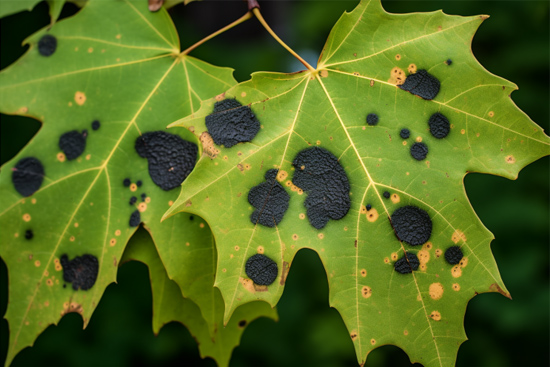
Key Takeaways
• Maple Tar Spot is a fungal disease caused by Rhytisma acerinum, which primarily affects maple trees through spots on leaves, leading to aesthetic rather than health impacts.
• The disease cycle of Maple Tar Spot includes the fungi overwintering in leaf debris, with spores spreading in spring via wind and rain, aided by moist environmental conditions that facilitate infection.
• Prevention and management of Maple Tar Spot involve the removal and disposal of infected leaves, maintaining overall tree health, and the potential use of fungicides or home remedies for treatment.
Understanding Maple Tar Spot
Maple Tar Spot is a fungal disease that affects maple trees, causing visible spots on the leaves. It is attributed to the Rhytisma fungus, and while it does not directly threaten the tree’s life, it can detract from its aesthetic appeal.
The Fungus Behind the Spots
The culprit behind Maple Tar Spot is Rhytisma acerinum, a fungus that infects newly emerging leaves. This infection process initiates leaf chlorosis, leading to yellow spots that later develop into brown-black, slightly raised lesions resembling tar as the season progresses.
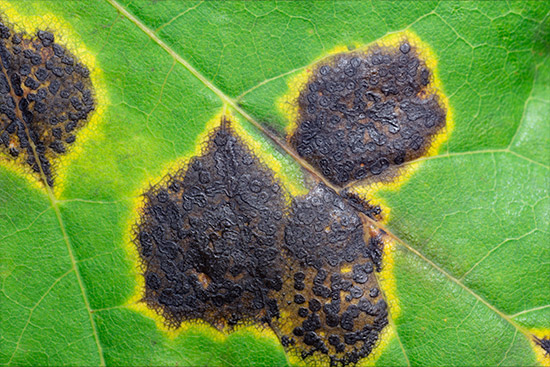
Rhytisma acerinum is characterized by its needle-shaped ascospores released in the spring from its overwintering state. This leads to the characteristic black tar-like spots on the upper surface of maple leaves, a sign that the fungi have successfully infected the tree.
Affected Maple Species
Maple Tar Spot can affect various Acer species with varying susceptibility levels. It mainly afflicts trees within the Acer genus, including native and foreign species.
Certain Acer species like Norway maples, particularly in the northeastern region of North America like Maine, show higher susceptibility to Maple Tar Spot. Non-native Acer species, especially the Norway maple, tend to be more prone to this disease.
Identifying Symptoms of Maple Tar Spot
Identifying the symptoms of tar in the form of Maple Tar Spot is key to managing the condition. Common signs include black fungal structures, known as stromata, appearing on the leaves. These raised, black spots on the leaf surface are visibly different from the typical appearance of a healthy leaf.
Early Signs: Yellow Spots
The early indicators of Maple Tar Spot are small yellow spots on the leaves of maple trees. These spots result from the presence of the Fungus Rhytisma, which generally does not cause significant harm to the tree besides affecting its visual appearance.
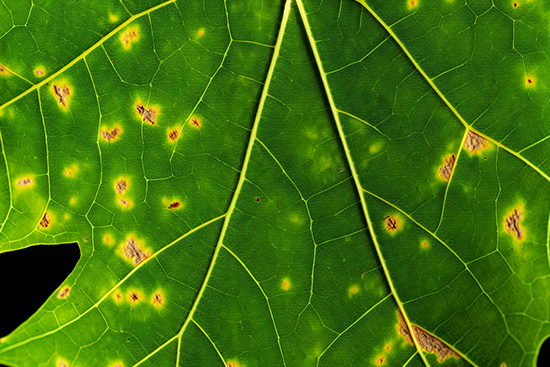
These yellow spots usually appear in early summer, following the infection of the maple leaves. Notably, these yellow spots can mimic the symptoms of other diseases like leaf rust and bacterial leaf spot diseases.
Progression: Black Tar Spots
As the Maple Tar Spot disease progresses, the small yellow spots on the leaves transition into dark, tar-colored spots by the end of summer, with a yellow area surrounding these more prominent black tar-like spots.
Upon close examination, these spots may measure one-half inch in diameter and exhibit a ridged appearance. The underside of the leaves affected by maple tar spot displays slightly lighter cupped black spots, indicating the fungal infection’s severity.
Disease Cycle and Spread
Comprehending the life cycle of the Rhytisma fungus and its method of spreading to maple trees is essential for combating this disease. The Rhytisma fungus overwinters in fallen leaves and releases spores in the spring to infect new leaves. These spores are disseminated to maple trees through wind and rain, and conditions such as rainy springs and mild winters contribute to the spread of the Maple Tar Spot disease.
Overwintering and Spore Release
Maple Tar Spot overwinters by residing in fallen leaves. The ability of the Maple Tar Spot fungus to overwinter successfully hinges on the availability of infected leaf debris. Consequently, removing these leaves is a pivotal step in combating the disease.
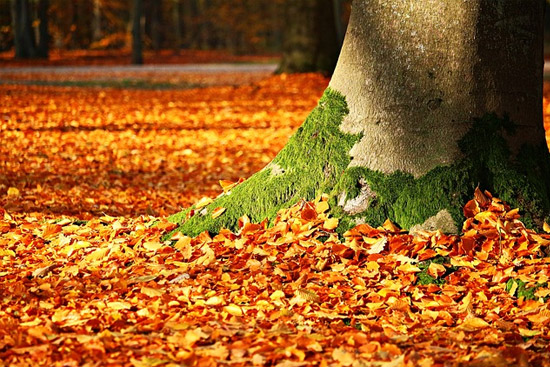
The Rhytisma fungus generally releases its spores during spring when new foliage is emerging. This is when the trees are most vulnerable to infection, and the spores can easily germinate on the leaves and penetrate the stomata, beginning the infection cycle.
Environmental Factors
Long periods of wet weather, such as fog, mist, and rain, as well as conditions that hinder leaf drying like consistent dense shading or overcast weather, cool temperatures (60 to 80 F), high relative humidity (>75%), frequent overcast days, and extended hours of dew at night, all favor the spread of Maple Tar Spot. These environmental factors can significantly influence the prevalence of this disease.
The presence of fungi on fallen leaves and specific environmental conditions, including shading and moisture levels, can contribute to the increased prevalence of the disease. Therefore, recommended environmental measures to mitigate the spread of Maple Tar Spot include:
• Reducing fungus levels by removing infected leaves
• Disposing of maple leaves in autumn
• Maintaining tree health through proper fertilization and watering.
Will Tar Spot Kill a Maple Tree – Its Impact on Health
Although Maple Tar Spot is mainly a cosmetic disease and does not significantly affect tree health, it can induce premature leaf drop in mature infected trees. However, it does not threaten its survival, even after repeated infections.
Maple Tar Spot is not known to significantly impact the health of young or newly planted maple trees; it is mainly considered a cosmetic concern.
Early Leaf Drop
Maple Tar Spot can lead to early leaf drop in mature trees but generally doesn’t cause substantial harm. In cases of heavy infestation, it may lead to early shedding of leaves, which results from leaves being too damaged to carry out photosynthesis and indicates a stress response in the tree rather than imminent tree death.
Normal leaf drop in maple trees occurs as part of the natural seasonal cycle, with the tree reabsorbing nutrients from the leaves before they fall. On the other hand, premature leaf drop is frequently a result of stress or infection, such as Maple Tar Spot, particularly in younger and more susceptible trees.
Other Species Affected
While Maple Tar Spot primarily affects maple trees, it can also impact other Acer species. It has the potential to affect several Acer species, such as:
• silver maple
• sugar maple
• Norway maple
• boxelder (Acer negundo)
Despite this, the primary impact of Maple Tar Spot is on trees within the Acer genus. This highlights the need to familiarize yourself with the disease and its symptoms if you have Acer species nearby.
Maple Tar Spot Treatment, Prevention, and Management
Appropriate leaf removal, tree health maintenance, and potential fungicide use are involved in the prevention and management of Maple Tar Spot.
However, the recommended strategies for preventing and managing maple tar spots involve cleaning and removing fallen leaves.
Removing Fallen Leaves
Reducing the spread of the fungi can be aided by removing fallen leaves. The fall season is the optimal time for raking and disposing of fallen leaves to prevent Maple Tar Spot.
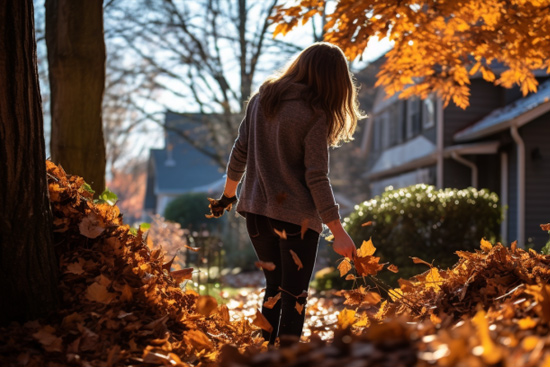
Fungal spores from fallen maple leaves can spread to other trees through wind or water. Ensuring that the compost heap reaches a high temperature, at least 140 degrees Fahrenheit, to kill the pathogens is advisable. Therefore, the appropriate procedure for disposing of fallen leaves contaminated with Maple Tar Spot is to clean up and remove the leaves from the affected trees.
Fungicide Options
Fungicides are a potential treatment for Maple Tar Spot, although their efficacy can be influenced by environmental variables such as temperature, rainfall, and relative humidity. Fungicide sprays containing copper and mancozeb applied appropriately during spring and with comprehensive coverage are approved for tar spot control and can eradicate the Maple Tar Spot fungus.
Homemade fungicide options for treating Maple Tar Spot include a mixture of baking soda and liquid soap, as well as using neem oil with baking soda. These DIY options can offer an affordable and environment-friendly alternative to commercial fungicides.
Summary
In summary, while Maple Tar Spot is primarily a cosmetic issue, understanding the disease, its symptoms, and its life cycle can help effectively manage it. While fungicides can aid in treating this disease, the main prevention strategy involves the timely removal and disposal of fallen leaves.
Maple Tar Spot Disease Frequently Asked Questions
Visit the following link for other maple tree diseases and information, and read below for the most common maple tar spot faq’s:
How do you treat tar spots on maple trees?
Raking up and destroying all infected leaves in the fall is recommended, as well as potentially using fungicides in case of high infection levels. However, controlling the disease is difficult.
Does maple tar spot come back every year?
Yes, maple tar spots can come back every year because the fungi responsible for the disease have an annual life cycle that includes overwintering and release of spores in the spring. This allows it to reinfect maple trees in the next growing season.
Is tar spot harmful to humans?
No, tar spots are not harmful to humans. While it produces toxins that can affect plant tissues and some animals, it does not affect humans.
What causes tar spot?
Tar spots are caused by the fungi Phyllachora maydis, which lead to small, raised, black, circular spots on corn leaves, stalks, and husks.
What is Maple Tar Spot?
Maple Tar Spot is a fungal disease that affects maple trees, causing visible spots on the leaves, and is attributed to the Rhytisma fungus.
This article was first published on: https://www.72tree.com/maple-tar-spot-disease-treatment/